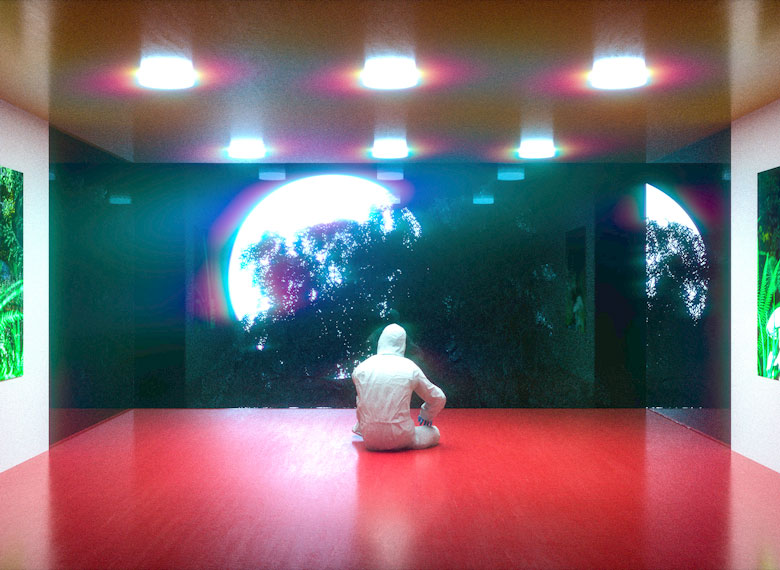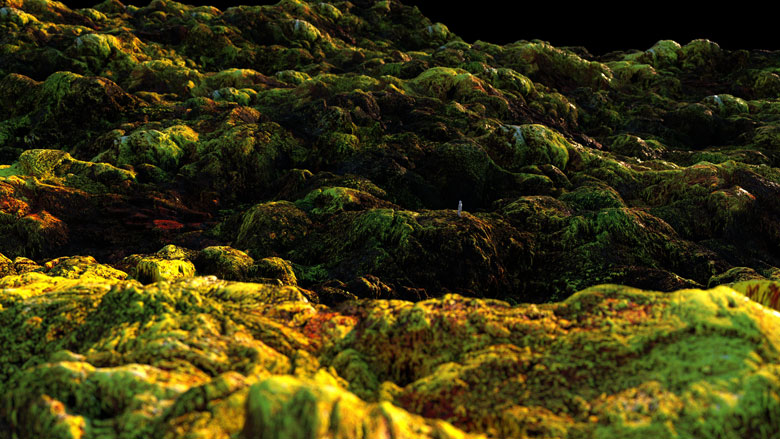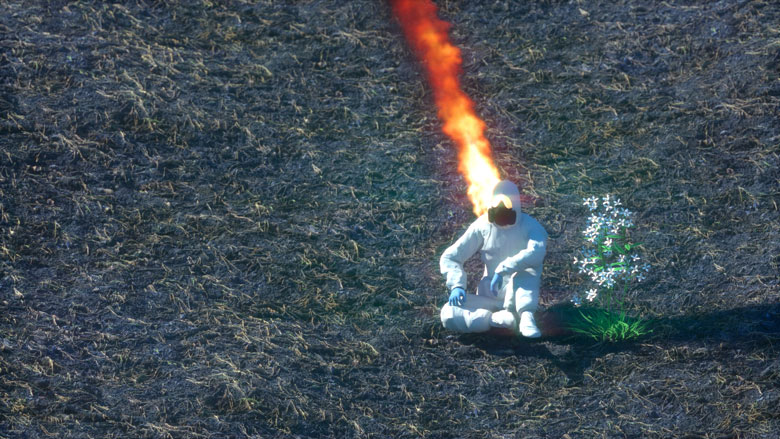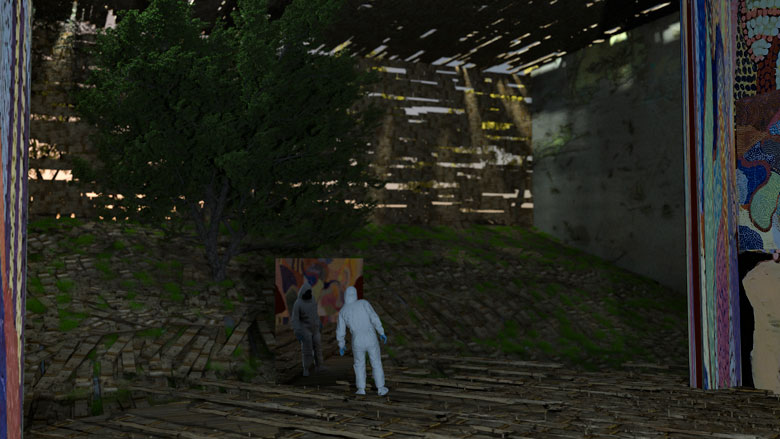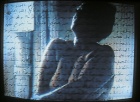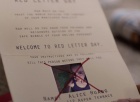Edmonton artist and writer Brad Necyk explores illness and its effect on individuals and communities. His multimedia, auto-ethnographic practice is the result of extensive time spent in vulnerable communities including neck cancer patients in Edmonton, the Iqaluit in the Canadian Arctic, and the Centre for Addiction and Mental Health (CAMH) in Toronto.
He is currently exhibiting his work at EMMEDIA’s PARTICLE + WAVE Media Arts Festival, and has a solo exhibition, Telling Stories Otherwise, at Alberta Printmakers in Calgary.
SHAUN CRAWFORD: According to your artist statement, "Illness is a vital meaning-making event." This is a powerful comment but notably doesn't carry any kind of value - no positive or negative connotation. Could you elaborate on what kind of meaning illness can bring to the lives and communities of people and why it's so important to explore that in your art?
BRAD NECYK: Illness can end worlds. Or at least the way you have been 'worlding' your world up to that point. Now that can be negative—something has changed out of your control—or it can be positive—an opportunity to grow. It's not binary, positive or negative, though it usually only feels negative because it hurts and it is scary, but as a whole experience, it is both. That is why it is so meaningful. It provokes sensations and realizations that challenge your world. We are all world, that is, we are world generating beings. I have a world and you have a world. Worlds are made up of fallible perceptions of what is out there, the sensations that arise from that inside oneself, and the stories our brain tells about these perceptions and sensations.
The stories we generate and tell ourselves matter deeply and are how we make meaning, or as Natalie Loveless writes: "Stories are powerful. The stories that we believe, the stories that we live into shape our daily practices, from moment to moment. They have the power to promise some futures and conceal others. They encourage us to see some things and not others."1
By telling whole stories, I hope it opens a safe, inclusive space that either validates someone's illness experience or creates a space for others to experience the possibilities of that experience.
When you become ill, your story changes in many ways, which shapes the way you experience your world (external and internal). You move from healthy, ripe with possibilities, to ill, your potentials are diminishing. You might also start to experience other stories, like "this will hurt," or the possibility of the experience of death. There are the stories you tell loved ones, so they understand. These might be factual medical narratives, or they might be your fears. But there are other stories, stories of empowerment, reconnection to loved ones, and of hope, and often we don't always experience these fully in our day to day lives.
Then there are other stories of resilience and change, which are opportunities for growth on how you see yourself and your future. As you go through an illness, your stories are challenged, you tell new ones, and, hopefully, these stories help you learn and cultivate something new within yourself. This has been my personal experience with trauma, illness, and healing.
My art explores these stories, both the negative and positive, and tries to tell a whole story (or stories that are just big enough). By telling whole stories, I hope it opens a safe, inclusive space that either validates someone's illness experience or creates a space for others to experience the possibilities of that experience.
SC: Your process involves immersing yourself in Canadian communities and with people experiencing illness. What Canadian communities have your collaborations taken you to and what have you taken with you after spending time in those locations?
BN: A lot of my research is field research. Witnessing is essential, but not as some outside, objective viewer at a distance, but one that is agape, open and vulnerable, and right there in the thick of it. It's a type of research that requires being-with-others and collaborating to make meaning and tell new and old stories. And as we collaborate, it renders all of us vulnerable to the possibility of that illness experience, and, as it has happened several times, I often become ill myself from the experience. I live with Bipolar Affective Disorder, and the challenging experiences often manifest in swings of depression or, more often, mania.
Then, the research is about investigating the relationship between other's experiences knotting and weaving with my own illness experiences. We lose the boundaries between your experience and my experience and become a larger experience and story.
Over the past four years, I have worked with head and neck cancer patients in Edmonton, I have traveled to Iqaluit in the Canadian Arctic to work on suicide, and to the Centre for Addiction and Mental Health (CAMH) in Toronto to work with psychiatric inpatients. In each of these settings, in different ways, I would try and embed myself within these communities, whether a high school of youths healing from a suicide epidemic or within a unit in a psychiatric hospital as patients recovered. I would go in with no plan, no set of objectives, and simply experience all I could, make connections with other people, and allow collaborations to unfold without pressure or guidance.
...the research is about investigating the relationship between other's experiences knotting and weaving with my own illness experiences. We lose the boundaries between your experience and my experience and become a larger experience and story.
From these experiences, I take away their hurt, but I also find folds of hope. Hope is a powerful way of storying. It takes the impossible and renders it possible. It changes you and it's infectious.
SC: For years you have been collaborating with people living with illness, co-creating your art. What is the process of co-creation with these individuals and how has that experience impacted you as an individual and an artist?
BN: When I enter a new community, I have no plans and I definitely don't know what or if we will co-create. And that is important. I can't force it. I just simply try to get to know people and go through their experiences with them. Illness is meaningful, and when you are experiencing something meaningful you make sense of it by expressing it and sharing it. Spending enough time together creates the conditions for that.
For example, at CAMH within the Youth Unit, that meant going to group therapy, meditation, and art therapy sessions. That meant eating together and going to play sports in the gym. And that meant sitting for hours while there was nothing formal planned for the patients. This is when we would talk, play games, and watch TV. Then, after five days, we collectively got an idea we needed to express. In this case, to paint a mural. We drew out a plan collectively and I drafted it on the wall. A line up of five or so kids picked up paintbrushes and started painting. Then one of the kids kicked over the paint bucket and it spilled on the floor. They laughed, and I saw them as kids being kids in unbelievable circumstances with unbelievable pasts. That is co-creating.
These experiences make me happy, they make me sad, they make me unable to go on, they make me forge on, they make me ill, but then they make me heal.
SC: The presence of place is very prevalent in your work. A combination of literal and representative spaces. Where do these environments come from and why are they important in conveying your message?
BN: I see these digital spaces as portals to another world. This world can have different physics, light, scale, and all the things that keep us rooted in our reality, but completely other. I believe art is about making worlds, where each artwork is a world to inhabit with its own properties. Then they become testing grounds to see how we experience in them, how we can imagine ourselves in them. The space and conditions created by art are a pull between contradictory poles, the rational and irrational, the ordinary and the extra-ordinary, the everyday and the sacred, and that allows us to experience, process, and integrate challenging contemporary and ancient problems.
This ability to think and experience otherwise is what makes art an advantageous behaviour that has existed across all human history and why it is so important now. So, when I make these spaces, I am trying to create worlds the artworks can inhabit but also the viewer can inhabit. Like we are in it together.
These experiences make me happy, they make me sad, they make me unable to go on, they make me forge on, they make me ill, but then they make me heal.
SC: Many of your visuals reappear in different pieces. There is a lot of intertextuality within your own work. What motivates you to repurpose these visuals across your portfolio, for example taking large scale paintings and placing them in your digital spaces?
BN: My work is auto-ethnographic—taking the personal and placing it in the social, a whole picture. That is how I weave my personal history with others. In my writing practice, I grab bits of written field notes, disparate moments, some theirs, some mine, and weave them together to make larger, longer stories. As Donna Haraway emphasizes, stories that are too big can overwhelm us and render us immobile, while stories that are too small are nothing to worry about.2What we need are stories that are just big enough that we are able to experience with, while still leaving the edges ripe with other potentials. I learnt a lot from bringing together these field notes.
I view my artworks as field notes—each an archive of an experience or sensation. The painting series you mentioned is an archive of the most severe manic episode of my life in June 2017 after returning back from CAMH. Over that month of mania, I created a series of paintings, almost a painting a day, and they are a record of that experience. They move from madness, dissolving portraits on fields of colour, to recovery, and to reconciliation with my family—this is where the kissing and hugging paintings come from. Those paintings are a story. All of the bodies of work in this show are field notes of experiences, so I create spaces for them to be in relationship together, in dialogue with each other. This is my form of visual auto-ethnography—placing personal and shared experiences across time together.
SC: "Large-scale photographic work, video, theatre, 3D imaging and printing, film, performance, sculpture, and installation art." And your work also spans other creative mediums from virtual reality to a collaborative dance project. Why does your practice span so many diverse mediums and what is your experience crafting your art through so many different channels?
BN: I’ll give a longer answer for this because this is something I am trying to think through right now. I believe there are different ways art expresses itself and can be viewed. Ellen Dissanayake describes art as an evolutionarily advantageous behaviour that spans all of human history.3Heidegger says art makes space for spaciousness. It opens worlds for others to inhabit. Art is not a thing or an object.4Stories from museums, critics, and the art market have confused that, or at least made it confusing for most people. Art is an experience, an experience we share and should not be closed off as a “thing” from other kinds of experiences. Noticing a beautiful moment is making art, finding pleasure in the everyday is making art, pausing and sensing sensations is making art. You aren't making objects in these moments but are framing experience off from everything else. You are elevating the ordinary to the extra-ordinary. That is being artful.
In our current time, we need to take back moments of artfulness that the art world, late capitalism, and despair have taken away as it engulfs everything. It has separated the artist out from the non-artists, and I think that is dangerous and is taking away an evolutionarily grounded behaviour from most people. I believe everyone is an artist, and if we are going to combat the many perils facing our contemporary world, then we need a new story of who is an artist and what is art. I believe this change in perspective could change the world. The creation of art is the way we come to know ourselves and our environment, both through our contemporary experiences but also the collective past we all share as a species and with all living beings on this planet. It taps into knowledge outside the realm of science or objective truth, a knowledge that is essential and universal. Allen Ginsberg once said, "poetry is words that are empowered to make your hair stand on end, that you realize instantly as being some form of subjective truth that has an objective reality to it because somebody has realized it. Then you call it poetry later."
Art makes space for spaciousness. Art is anti-individual and is there for everyone. It’s up to artists to open more space for that.
That is a long way of preparing to answer this question. I believe an artist is a master of nothing but good at many things. This idea moves the emphasis from technique and mastery and gives everyone a means of expression. If you dedicate yourself to one form of expression (though this can be productive and meditative), you close yourself off to the possibilities of other expressions, other ways of thinking through a problem or sensation, other experiences. Identifying yourself with a media like "I am a painter" or "I am a sculptor" just doesn't make sense to me. You are not an extension of form, you are a conduit for expression, and you need to allow that expression to find its form. That's why I work in so many different ways. It keeps the edges ripe with possibilities. It keeps you open. It keeps you engaged. It pushes your understandings and makes you curious.
Staying fluid and not pinned down allows you to access creative spaces because you are forced to be in the moment, to be attentive, attuning yourself to experiences as they unfold in your mind and out of your mind. Heidegger mentions that the artist is destroyed once they create art. Maybe I am destroyed each time I create and can’t find my way back to that form and must forge forward. It’s a way of resisting that dominating narrative of mastery. I refuse to be part of that anymore. I won’t teach that anymore.
Art is an experience framed off from the everyday, that elevates into the extra-ordinary, that makes our hair stand on end, and generates knowledge, stories, and worlds, and must be accessible to all as experience and not only be about form, things, and objects. Art makes space for spaciousness. Art is anti-individual and is there for everyone. It’s up to artists to open more space for that. To quit gobbling up the edges and sectioning things off. Opening to that possibility has changed my experience of art and the life that encompasses it.
SC: Due to these diverse mediums, you exhibit shows in a number of different contexts and gallery spaces. In Alberta alone to start 2020 you're participating in the PARTICLE + WAVE Media Arts Festival at EMMEDIA, the International Festival of Winter Cinema in Edmonton, and you have a solo show at Alberta Printmakers. How is it that your work is so relevant and has a place in different venues, in this case both analogue and digital?
BN: I am just a storyteller. Want a different world? Tell a different story. That is what I am after. I am lucky to have so many venues to share these stories.
SC: By spending time with your work, and in your own descriptions of yourself and your practice, you discuss that the most important aspect of yours or any practice is to contribute to lasting change on both an individual and societal level. What is your greatest hope for what people will take away from experiencing your work?
BN: Most importantly, I hope my art creates a safe, inclusive space to experience. I don't like art that leaves people out, like when they don't get the "art joke" in the work. That's too self-referential, art reflecting on art, and it alienates people. Art needs to create the possibility to include everyone. I hope that by sharing my story, it will open people to share theirs. Then we have more stories to story with, to world with, and understand how we got here and how to go from here to there. That’s what I am trying to do personally as I create art, but something I hope everyone will join in on if we make the space.
Also, I hope to story otherwise. To create other stories we live our lives by, stories we experience through, and stories we make meaning by. I hope to challenge old, tired stories that aren't usable to think with anymore. I think co-creating is storying otherwise. It includes the "non-artists" as creators and collaborators. I have heard my collaborators express this many times. Maybe they will have new confidence to express themselves going forward. I think creating work about marginalized people is storying otherwise. These are stories that are left out, and art is about including, sharing, and listening.
Representation matters. I think claiming more space for art, more footing to step out onto is storying otherwise. The 20th-century really sectioned off art and the artist from everything else. I think the 21st-century is about claiming that back and that will require storying otherwise, reclaiming in radical ways, expanding, and sharing. This last statement is what I hope to spend the next few years on because I see a world in pain and as I experience that pain, I can’t help but hope for a better future. I believe art can help us create new experiences and worlds for us to inhabit, priming us to change our own. I believe art can change the world.
Brad Necyk's solo exhibition Telling Stories Otherwise is currently exhibited at the Alberta Printmakers' Main Space Gallery from January 10 - February 28, 2020, including Necyk’s video installation And All Of Everything (Joshua Tree): https://vimeo.com/bradnecyk. He is also featured in the PARTICLE + WAVE: Group Exhibition at EMMEDIA Gallery & Production Society with his video installation Solastalgia from January 31 - February 29, 2020.
In addition to his international exhibitions, Brad Necyk has had multiple solo and group exhibitions in Edmonton, as well as film screenings and theatre projects including his upcoming Stormshelter at the Art Gallery of Alberta. He was recently awarded the Governor General’s Gold Medal for his doctoral research while completing his arts-based, research-creation PhD in Psychiatry at the University of Alberta.
To learn more about Brad and his artistic practice: www.bradnecyk.com
Shaun Crawford's first love is writing, having written for radio, commercials, web, short and long form film, and extended reality mediums. His films have aired on CBC, HBO, The Movie Network, Showtime, and screened at festivals in Canada and the US. He is currently the Creative Captain of MAMMOTH XR, writing and directing augmented and virtual reality experiences. A passionate supporter of dreamchasers, Shaun believes in the magic of storytelling to explore the human experience.
Shaun Crawford interviewed Brad Necyk in Edmonton via email in January 2020.

